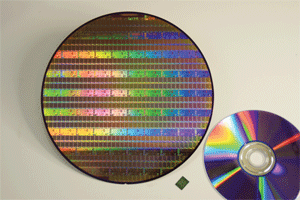Nonvolatile phase-change memory is now sampling
Intel (Santa Clara, CA) has engineering samples of a 128-Mbit phase-change memory available (under NDA agreement) for the first time. The non-volatile devices are fabricated using 90-nm technology, and Intel expects to quickly move to smaller dimensions with an “excellent scaling path to the future.” The chips read/write speed is nearly that of DRAM and much faster than NAND flash. The chip is also bit alterableso you do not have to erase an entire 512 or 1-Kbit sector. The technology’s endurance is greater than 100,000 cyclesbut not as high as the nearly infinite DRAMand it needs about the same power as NAND flash.

Intel’s PCM nonvolatile memory has read/write speeds nearly as fast as DRAM.
Phase change memory (Intel refers to it as PCM) relies on an alloy similar to those used in optical disk applications that is heated to a high temperature (over 600°C), at which point it becomes a liquid. Once cooled, it is frozen into an amorphic glass-like state and its electrical resistance is high. By heating the alloy to a temperature above its crystallization point, but below the melting point, it will transform into a crystalline state with a much lower resistance. This phase transition process can be completed in as quickly as five nanoseconds, with a variation in electrical conductivity of six orders of magnitude.
A number of companies are researching PCM including Samsung, STMicroelectronics, IBM, Hitachi, and Renesas. Intel expects the 128-Mbit device to be in full production by approximately the middle of next year and did not disclose the price of the chip. For more information, visit http://www.intel.com.
Jim Harrison
Advertisement
Learn more about Intel





